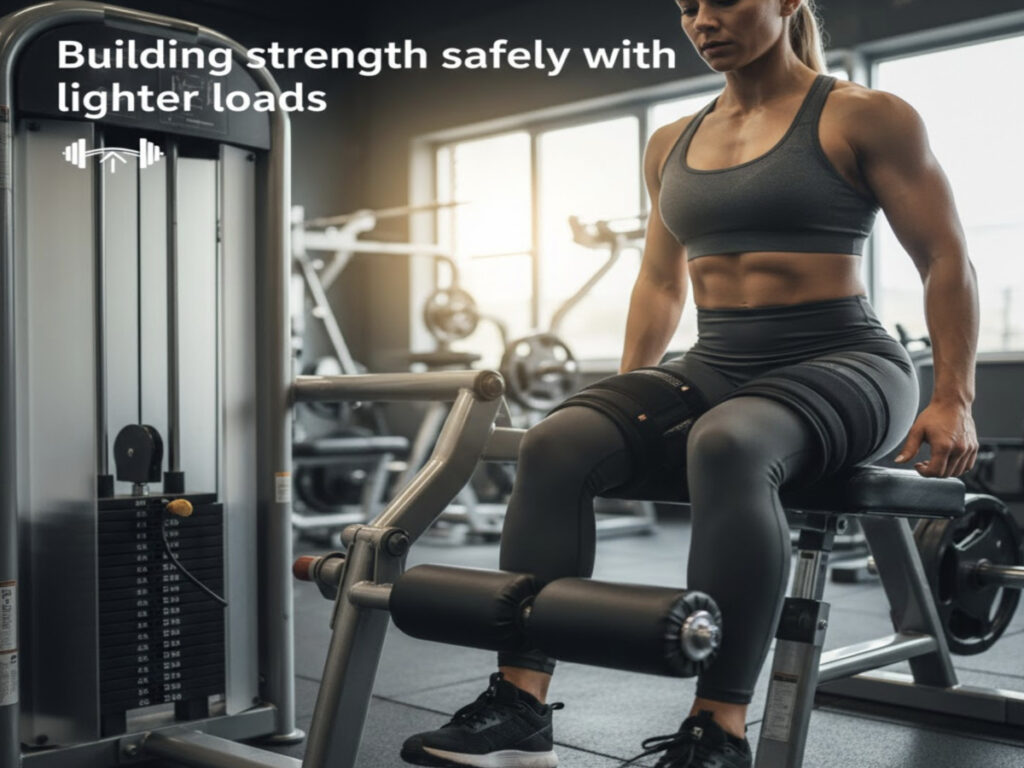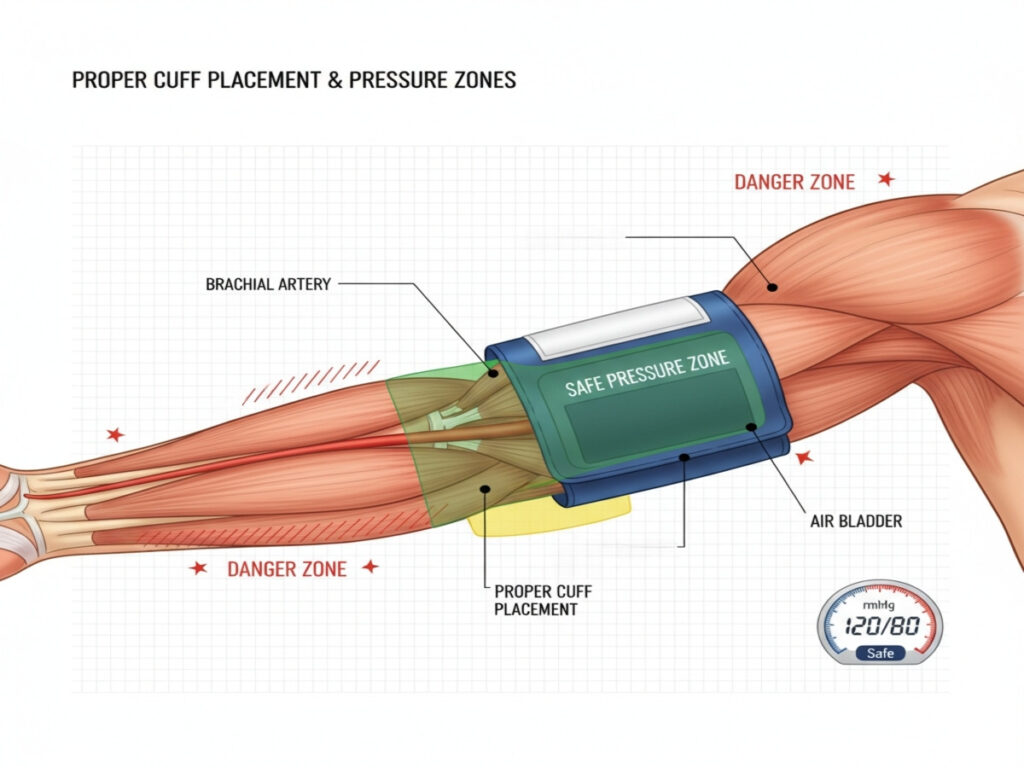Introduction: What Is Blood Flow Restriction Training?
Blood Flow Restriction (BFR) Training—also called occlusion training—is a breakthrough method that enables you to build muscle and strength using lighter weights by strategically restricting blood flow to working muscles.
Originally developed in Japan as “KAATSU Training” in the 1960s, BFR has now become a clinically validated and gym-tested tool for muscle growth, rehabilitation, and longevity training—especially for those who can’t lift heavy due to injury or joint pain.

The Science Behind BFR
During BFR, elastic cuffs or bands are placed near the top of your arms or legs to partially restrict venous blood flow while allowing arterial inflow.
This creates a localized hypoxic (low-oxygen) environment, signaling your muscles that they’re working harder than they actually are.
The result: hypertrophy and strength gains similar to traditional heavy training—but with weights as light as 20–30% of your one-rep max (1RM).
“Blood flow restriction training is one of the few methods that can stimulate Type II muscle fibers with low-load exercise—a game changer for rehabilitation and older adults,”
— Dr. Jeremy Loenneke, PhD, University of Mississippi, BFR Research Lab.
How BFR Builds Muscle with Lighter Loads
Under normal resistance training, mechanical tension and muscle damage drive hypertrophy.
With BFR, metabolic stress becomes the primary growth trigger.
By restricting venous return, lactic acid and metabolites build up, stimulating anabolic signaling pathways such as:
- mTOR activation: Enhances muscle protein synthesis
- Growth hormone release: Elevated up to 290% post-BFR session
- Cell swelling: Increases intramuscular pressure, signaling adaptation
Statistic: A 2024 review in Frontiers in Sports Medicine reported that BFR combined with low-load resistance increased muscle size by 30–40% more than the same load without restriction.
Key Benefits of Blood Flow Restriction Training
| Benefit | Description |
|---|---|
| Muscle growth with light weights | Achieve hypertrophy using 20–30% of 1RM |
| Joint-friendly | Reduces strain on connective tissue and joints |
| Rehabilitation tool | Used in post-surgery recovery (ACL, rotator cuff) |
| Time-efficient | Shorter sessions produce comparable results |
| Hormonal boost | Increases GH and IGF-1 naturally |
| Improves endurance | Enhances capillarization and muscle oxygen use |
Physiological Mechanisms: Why It Works
- Metabolite Accumulation: Increased lactic acid triggers muscle fiber recruitment.
- Fiber Recruitment: Type II fibers (fast-twitch) activate even at low intensities.
- Anabolic Signaling: Increases IGF-1 and mTOR pathways for protein synthesis.
- Cell Swelling: Mechanical stress enhances hypertrophy signaling.
- Hormonal Cascade: Elevates testosterone and GH post-session.
“BFR provides the same muscle stimulus as heavy lifting without mechanical damage—a major innovation in recovery and rehab settings,”
— Dr. Brad Schoenfeld, Exercise Science Researcher, Lehman College.
Ideal Candidates & Safety Precautions
Who Benefits Most
- Individuals recovering from injury or surgery
- Older adults seeking to preserve muscle mass
- Busy professionals needing shorter, effective workouts
- Athletes managing joint stress
Precautions
- Never fully occlude blood flow
- Avoid use with cardiovascular disease or clotting disorders
- Consult a healthcare professional before starting

How to Get Started: Step-by-Step Guide
- Select target limb (arms or legs).
- Wrap BFR cuffs high on the limb—snug but not painful.
- Choose resistance: 20–30% 1RM.
- Perform 30 reps, rest 30 seconds, then 3 sets of 15 reps.
- Rest between sets: 30–45 seconds.
- Total occlusion time: ≤ 10 minutes per muscle group.
Recommended BFR Gear & Pressure Guidelines
| Equipment Type | Pressure Range | Best For |
|---|---|---|
| Elastic bands | 40–60% limb occlusion | Beginners |
| Pneumatic cuffs | 50–80% limb occlusion | Advanced users |
| Smart cuffs (auto-calibrated) | Personalized via limb occlusion pressure (LOP) | Clinical or rehab settings |
BFR for Different Training Goals
| Goal | Load | Reps × Sets | Rest |
|---|---|---|---|
| Hypertrophy | 20–30% 1RM | 30-15-15-15 | 30 s |
| Endurance | 15–25% 1RM | 4×20 | 20 s |
| Rehabilitation | Bodyweight only | 3–4 sets × 15–30 reps | 30 s |
| Maintenance (Longevity) | 25–35% 1RM | 3×15 | 45 s |
Common Mistakes to Avoid
❌ Wrapping too tight (causes numbness)
❌ Using heavy weights (defeats the purpose)
❌ Long occlusion time (> 15 minutes)
❌ Ignoring warm-up and hydration
❌ Skipping recovery nutrition
Actionable BFR Training Blueprint
Weekly Frequency: 2–3 sessions per muscle group
Duration: 15–20 minutes total
Sample Routine:
- Leg Day: BFR Squats, BFR Leg Extensions
- Arm Day: BFR Curls, BFR Triceps Push-downs
Nutrition Tip: Consume 20–30 g of protein post-BFR to maximize muscle protein synthesis.
Expert Insights on BFR Training
“For aging adults, BFR training bridges the gap between rehabilitation and performance—it’s the future of joint-safe resistance exercise.”
— Dr. Nick Rolnick, DPT, Founder of The BFR Pros.
“When used correctly, BFR offers 80% of the hypertrophy benefits of heavy training at only 30% of the load.”
— Dr. Carlos Ugrinowitsch, University of São Paulo.
FAQs
Q1: Is BFR safe for beginners?
A: Yes, when using proper pressure and supervision. Start with elastic bands and light loads.
Q2: How often can I do BFR training?
A: 2–3 times per week per muscle group is effective and safe.
Q3: Does BFR replace heavy training?
A: It complements it. Alternate BFR sessions with traditional lifting for optimal results.
Q4: Can I use knee wraps or tourniquets?
A: No. Only use equipment designed for BFR to avoid injury.
Authoritative Resources
- National Strength and Conditioning Association – BFR Training Guidelines
- American College of Sports Medicine – Position Stand on Resistance Exercise
- Journal of Strength and Conditioning Research – BFR Applications
Other Interesting Articles
- Biohacking Blood Pressure: Innovative Strategies for Heart Health in 2025
- Mindful Breathing Workouts: The Secret Weapon for Stress Resilience in 2025
Conclusion & Call-to-Action
Blood Flow Restriction Training is redefining how Americans approach strength and rehabilitation. It delivers the muscular and hormonal benefits of heavy lifting—without the joint stress or injury risk.
If your goal is to build muscle, recover smarter, or train for longevity, BFR offers a scientifically backed, time-efficient solution.
Take action today: Try BFR once per week using proper technique and professional gear. Your muscles—and joints—will thank you.

